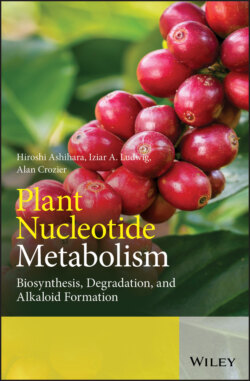Читать книгу Plant Nucleotide Metabolism - Hiroshi Ashihara - Страница 17
1.3.1.3 Purine Nucleotides
ОглавлениеA nucleotide is composed of a purine base, a sugar moiety (ribose or deoxyribose) and at least one phosphate group. The phosphate group is attached to either the C3′or C5′ position of the sugar. Nucleoside-5′-phosphates (5′-nucleotides) are the main purine nucleotides in plants as well as other organisms. Small nucleoside-3′-monophosphate (3′-nucleotides) pools are mainly produced as catabolites of nucleic acids. Examples of different forms of nucleotides are adenosine-5′-monophosphate (5′-AMP, usually abbreviated as AMP) (23), adenosine-3′-monophosphate (3′-AMP) (24), deoxyadenosine-5′-monophosphate (dAMP) (25), and isopentenyladenine ribotide (26).
The cyclic monophosphates, cyclic adenosine-3′,5′-monophosphate (cAMP) (27) and cyclic guanosine-3′,5′-monophosphate (cGMP) occur in plants. These cyclic nucleotides are derived from ATP and GTP and act as second messengers. In addition, some unusual nucleotides, such as guanosine tetraphosphate (ppGpp), guanosine pentaphosphate (pppGpp) (28), diadenosine triphosphate (Ap3A), and diadenosine tetraphosphate (Ap4A), known as alarmones, which act as intracellular signal molecules, are produced in response to harsh environmental conditions (Boniecka et al. 2017; Pietrowska-Borek et al. 2011). Possible roles of these unusual nucleotides in plants are outlined in Part VIII.
